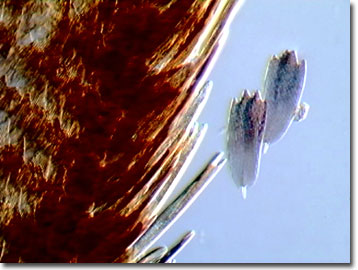Butterfly Wing Scale Digital Image Gallery
Tawny Owl Butterfly
Insects in the genus Caligo, known as the owl butterflies, are very large tropical species famous for the large eyespots on the undersides of their wings. Visible when the wings are closed and held upright, potential predators often reconsider attacking something that appears so imposing. The yellow eyespots remind most observers of owl eyes, but some behavioral lepidopterists believe the butterflies mimic a toxic tree frog that resides in the same ecosystem.

Part of the family Nymphalidae, the tawny owl butterfly ranges from Mexico, through Central America, and into the Amazon Basin of South America. In flight, spectators may not be able to easily identify owl butterflies because the upper sides of their wings do not have the same dramatic eyespots that are featured on the undersides. Instead, the wing upper sides are covered in various iridescent color combinations that may aid in species recognition and in avoidance of hybridization. Additionally, ripple effects caused by the colorful wing patterns may add to the confusion of predators trying to detect the outline of their prey. Many owl butterflies in the wild are found with a piece of their hind wings missing, indicating that even if a predator is not deterred by the eye spots and wing colors, it may be fooled into attacking the wing instead of the vital butterfly body.
Female tawny owl butterflies lay groups of pinkish eggs on the undersides of banana tree leaves and other vegetation, such as plantains, parrot's flowers, and prayer plants. The voracious larvae that hatch from them can ingest incredible quantities of leaves and grow to enormous sizes of up to 160 millimeters long and 15 millimeters thick. The young, brown caterpillars are gregarious while feeding and are most active at dawn and dusk. By the third larval stage feeding is nocturnal and during the day the yellow-green caterpillars rest on the lower surfaces of leaves upon silken cushions. The agricultural pests feature evertable prothoracic organs, which emit defensive chemicals that are quite effective, even against the dreaded army ants of the Amazon. In the pupal stage, the tawny owl chrysalis is a bright yellow, which helps it blend in with surrounding ripening fruits.
Although a significant portion of the natural habitat of the tawny owl butterfly has been destroyed throughout the tropical Americas, it has been replaced in some areas with banana and plantain plantations. The tawny owl caterpillars are, however, killed in masses due to essentially unrestricted pesticide applications used to protect the economically important cash crops. Organically grown banana crops are protected from excessive larval damage by biological controls, such as parasitic wasps and mites.
Tawny Owl Butterfly Images in Brightfield Illumination
Wing Scale Array - An area of white and purple, oval shaped wing scales are displayed in this high magnification brightfield image. Their overlapping pattern and rounded edges are beautifully exhibited.
Tawny Owl Butterfly Images in Darkfield Illumination
Wing Scale Interference Patterns - The wing scales in this image appear to have sharp, jagged edges. Interference patterns highlight the regimented rows of scales.
Tawny Owl Butterfly Images in Oblique Illumination
Fur on Wing - The surface of the tawny owl butterfly wing appears to be covered in golden feathers in this photomicrograph. The avian-like appearance provides a better understanding of the common name of the species.
Wing Scale Interference Patterns - The interference patterns are so heavy in this oblique illumination image that the individual wing scales can hardly be discerned. The markings that look similar to fingerprints make this an unusual, but interesting photomicrograph.
Edge of Wing (Low Magnification) - This photomicrograph captured in oblique light features the feathery edge of a tawny owl butterfly wing. The scales appear elongate and heavily layered.
Edge of Wing (High Magnification) - This image was captured under a slightly higher level of magnification than the previous photomicrograph. The tips of the scales have a serrated appearance.
Tawny Owl Butterfly Images in Reflected Light
Black and White Wing Scales (Low Magnification) - In this low magnification image, a large field of contrasting black and white rows of wing scales are bordered by a spot of golden brown.
Black and White Wing Scales (High Magnification) - The black and white wing scales appear to be in a zebra-like pattern under an increased level of magnification.
Contributing Authors
Cynthia D. Kelly, Shannon H. Neaves, Laurence D. Zuckerman, and Michael W. Davidson - National High Magnetic Field Laboratory, 1800 East Paul Dirac Dr., The Florida State University, Tallahassee, Florida, 32310.
BACK TO THE BUTTERFLY WING SCALE IMAGE GALLERY
BACK TO THE DIGITAL IMAGE GALLERIES
Questions or comments? Send us an email.
© 1995-2025 by Michael W. Davidson and The Florida State University. All Rights Reserved. No images, graphics, software, scripts, or applets may be reproduced or used in any manner without permission from the copyright holders. Use of this website means you agree to all of the Legal Terms and Conditions set forth by the owners.
This website is maintained by our
Graphics & Web Programming Team
in collaboration with Optical Microscopy at the
National High Magnetic Field Laboratory.
Last Modification Friday, Nov 13, 2015 at 01:19 PM
Access Count Since January 21, 2003: 22253
Visit the website of our partner in introductory microscopy education:
|
|
